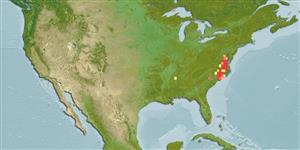Classification / Names
Common names | Synonyms | Catalog of Fishes (gen., sp.) | ITIS | CoL | WoRMS | Cloffa
Actinopterygii (ray-finned fishes) >
Esociformes (Pikes and mudminnows) >
Umbridae (Mudminnows)
Etymology: Umbra: Latin, umbra, -ae = shadow, in the sense of phantom; due to its quick movements (Ref. 45335).
Environment / Climate / Range
Ecology
Freshwater; demersal; pH range: 6.0 - 6.5; dH range: 3 - 8; non-migratory. Temperate; 4°C - 23°C (Ref. 1672), preferred ?; 42°N - 30°N
North America: Atlantic and Gulf slopes from southeastern New York (including Long Island) to St.Johns River drainage in Florida and west to Aucilla River drainage in Florida and Georgia, USA (Ref. 5723). Introduced (but very localized) to central and western Europe (Ref. 59043).
Length at first maturity / Size / Weight / Age
Maturity: Lm 3.7 range ? - ? cm
Max length : 13.7 cm TL male/unsexed; (Ref. 88166); 15.0 cm TL (female)
Dorsal
spines
(total): 0;
Dorsal
soft rays
(total): 14-15;
Anal
spines: 0;
Anal
soft rays: 8 - 11. Body robust, thick, little compressed; head bluntly conic; snout short, equal to diameter of eye; mouth moderate, jaws short, mandible protrudes slightly beyond tip of upper jaw, premaxillaries not protractile. Gill rakers short and numerous. Dorsal inserted near pectoral than caudal base; pelvic inserted just before origin of dorsal , rays of depressed fin reaching to about 3rd anal ray. Caudal fin rounded, with 18-20 rays (Ref. 2196).
Pigmentation: yellowish green with 10-12 narrow lateral dark stripes; a dark stripe through eye; a black basicaudal bar; lower jaw pale; fins plain. Also Ref. 40476.
Inhabits quiet streams, sloughs, swamps and other wetlands over sand, mud and debris, often among dense vegetation. Juveniles also found among aquatic vegetation, often forming schools of 10-12 individuals (Ref. 39069). An introduced species in Europe which usually occurs in small isolated ponds and peat bogs (Ref. 59043). Oviparous, larvae remain in algal nest for about 6 days (Ref. 39067). Spawning takes place in April and May (Ref. 30578). Feeds on insect larvae, worms, mollusks, crustaceans alevins. Experimental studies show that this species can tolerate acidic environment, particularly, at ph values ranging from 4.0 to 7.0 where no mortality or significant changes in blood plasma osmolarity and haematocrit was observed (Ref. 59260).
Page, L.M. and B.M. Burr, 1991. A field guide to freshwater fishes of North America north of Mexico. Houghton Mifflin Company, Boston. 432 p. (Ref. 5723)
IUCN Red List Status (Ref. 115185)
CITES (Ref. 94142)
Not Evaluated
Threat to humans
Harmless
Human uses
Fisheries: of no interest; aquarium: commercial
More information
ReferencesAquacultureAquaculture profileStrainsGeneticsAllele frequenciesHeritabilityDiseasesProcessingMass conversion
Tools
Can't connect to MySQL database fbquizv2. Errorcode: Too many connections
